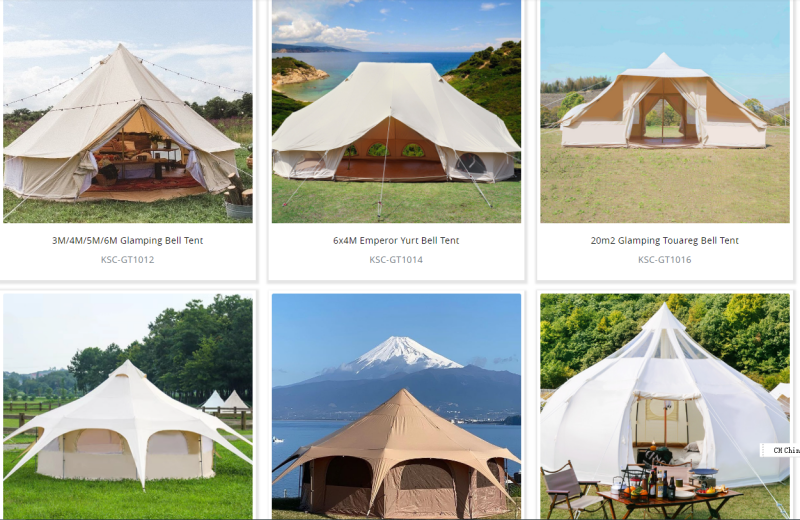What are the Shapes of Glamping Tent? And Their Pros and Cons
Glamping tents come in various shapes, each offering unique benefits and drawbacks. Here’s a more in-depth look at the various shapes of glamping tents, along with their characteristics, advantages, disadvantages, and suitable applications.
-
Description: Typically features a semi-spherical shape with a rounded top. Often made of durable fabric supported by a frame.
-
Construction: Usually has two or more poles crossing in the center, creating a stable structure.
-
Pros:
- Wind Resistance: The aerodynamic shape allows wind to flow over rather than against the tent.
- Interior Space: Offers a high ceiling and ample floor space, making it comfortable for standing and moving around.
- Setup: Generally easy to assemble with fewer parts.
-
Cons:
- Limited Luxury Options: The design may not support heavy furnishings or elaborate setups.
- Condensation: Can have issues with condensation build-up, especially in cooler climates.
-
Applications: Suitable for quick setups in festivals, backyard glamping, and casual camping.
-
Description: Cone-shaped with a wide base and a high peak. Made of canvas or heavy-duty fabric.
-
Construction: Supported by a central pole, with additional guy lines for stability.
-
Pros:
- Aesthetic Appeal: Offers a classic, rustic look that is popular among glampers.
- Spaciousness: Plenty of interior space for various configurations, from beds to lounge areas.
- Ventilation: Typically has flaps and windows for airflow, keeping the interior comfortable.
-
Cons:
- Stability: Requires good anchoring to withstand high winds.
- Setup Complexity: More components can mean a longer setup time compared to simpler designs.
-
Applications: Ideal for luxury camping sites, yoga retreats, and family camping trips.
3. Geodesic Domes
-
Description: Composed of triangular panels that form a spherical structure, providing a modern look.
-
Construction: Typically built from metal or wood frames covered with durable fabric.
-
Pros:
- Strength: The geometric design distributes stress evenly, making it highly stable and resilient.
- Insulation: Efficient at maintaining temperature, keeping the interior warm in winter and cool in summer.
- Unique Experience: Offers a visually striking space that enhances the glamping experience.
-
Cons:
- Cost: More expensive due to complex design and construction materials.
- Setup Time: Requires more expertise to assemble, which can be challenging without prior experience.
-
Applications: Great for eco-resorts, adventure retreats, and unique vacation rentals.
-
Description: Rectangular tents designed to mimic luxury safari accommodations, often with elevated wooden platforms.
-
Construction: Made of heavy-duty canvas, often with wooden or metal frames.
-
Pros:
- Amenities: Often come equipped with en-suite bathrooms, electricity, and furniture.
- Spacious Layout: Allows for family-sized accommodations with multiple rooms.
- Comfort: Combines outdoor experience with indoor comfort.
-
Cons:
- Transport: Heavier and more challenging to set up, requiring a more permanent installation.
- Cost: Higher initial investment due to size and included amenities.
-
Applications: Perfect for family vacations, luxury campgrounds, and eco-lodges.
5. Yurts
-
Description: Circular, tent-like structures traditionally used by nomadic cultures, featuring a wooden frame covered with fabric or felt.
-
Construction: Made with a circular wooden base and a lattice wall structure supporting the roof.
-
Pros:
- Space Efficiency: The circular design maximizes usable interior space, making it feel larger.
- Insulation: Excellent thermal properties, providing comfort in various climates.
- Customization: Can be fitted with modern amenities like heating, plumbing, and electricity.
-
Cons:
- Complex Setup: Requires skilled labor for setup, especially with the wooden frame.
- Permanent Installations: Often considered a more permanent structure, which may not suit transient glamping setups.
-
Applications: Ideal for luxury resorts, eco-lodges, and unique vacation experiences.
-
Description: Rectangular or square tents that resemble cabins, often with solid floors and walls made of heavy-duty fabric.
-
Construction: Designed to be more robust, sometimes featuring wooden frames and multiple rooms.
-
Pros:
- Durability: Made from high-quality materials that withstand weather elements.
- Home-like Experience: Offers a more comfortable, rustic cabin feel with plenty of space.
- Room Divisions: Ideal for families or groups needing separate areas.
-
Cons:
- Weight and Portability: Heavier and more cumbersome to transport and set up.
- Setup Time: Longer setup time compared to simpler tent designs.
-
Applications: Suitable for family camping, group retreats, and glamping resorts.
Summary
Choosing the right glamping tent shape depends on your specific needs, such as aesthetic preferences, desired comfort level, and the intended glamping experience. Each type offers unique benefits and potential challenges, making it essential to consider factors like location, climate, and personal style when selecting the perfect glamping tent.

KASSICO is a professional luxury glamping tents and commercial tent manufacturer in China with more than 10 years of experience, With our R&D team, advanced CNC machine manufacturing, well-equipped testing equipment, and sewing team, We provide various styles and sizes of inflatable tents, custom camping tents, backpacking tent, The products perfect used for campsites, hotel, resort, homestay, staycation, and farm stay we provide an excellent tent designing, manufacturing, selling, and customized service. We have a strong design team, we can customize your style based on the customer's original sample or specification sheet.

